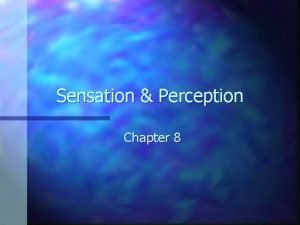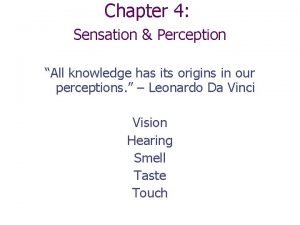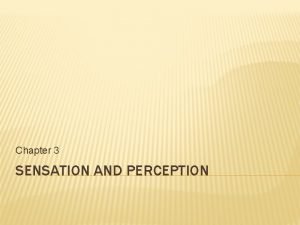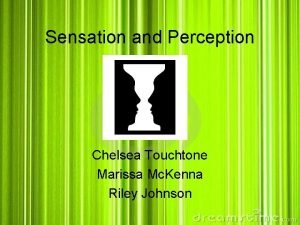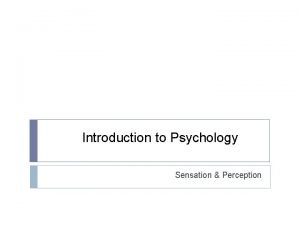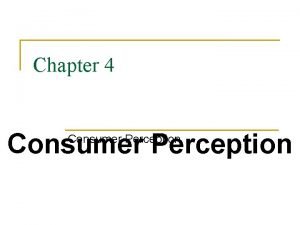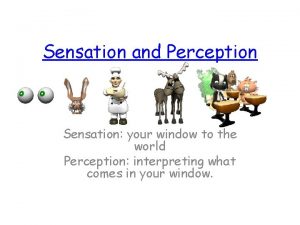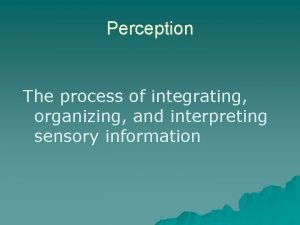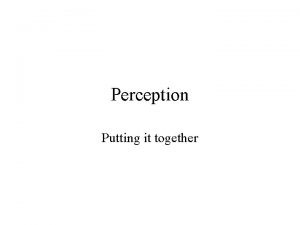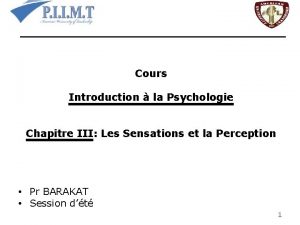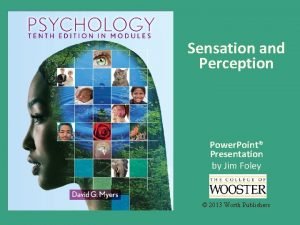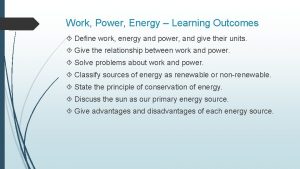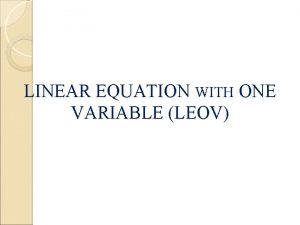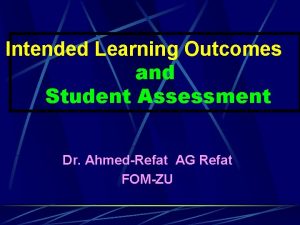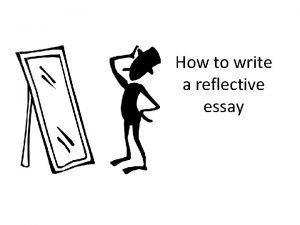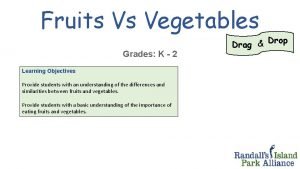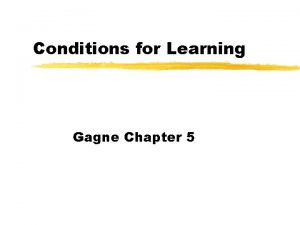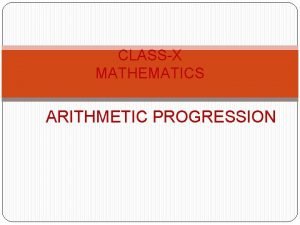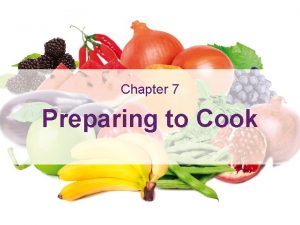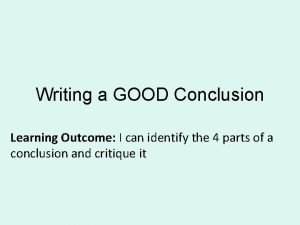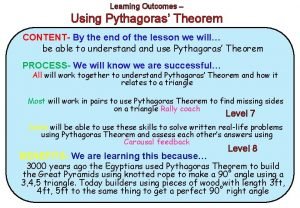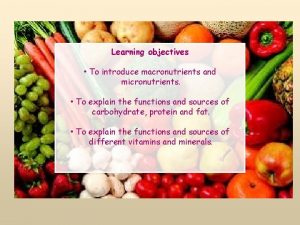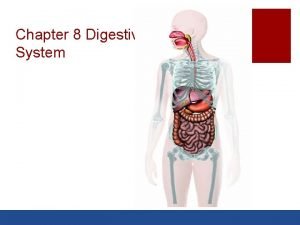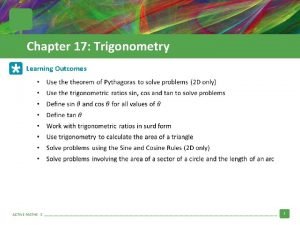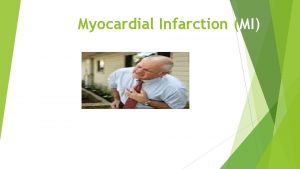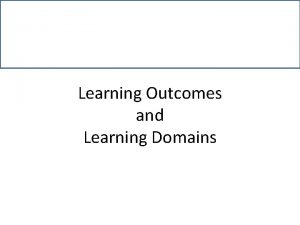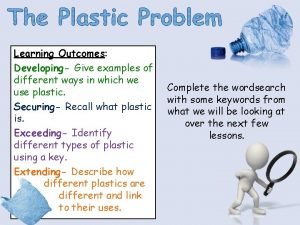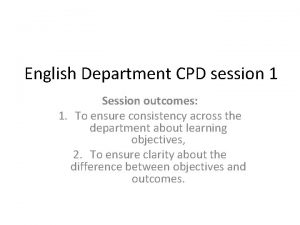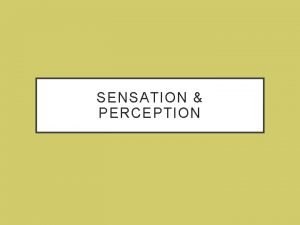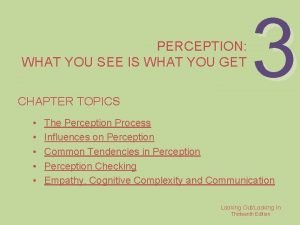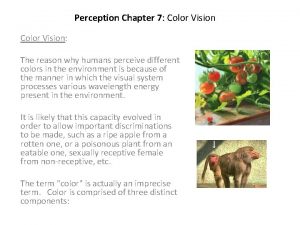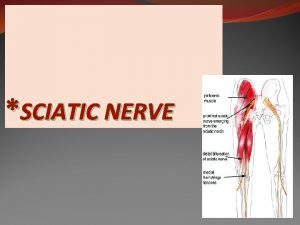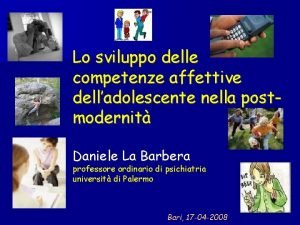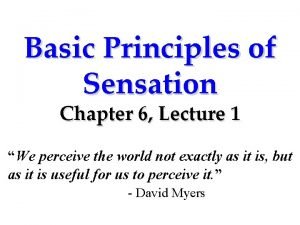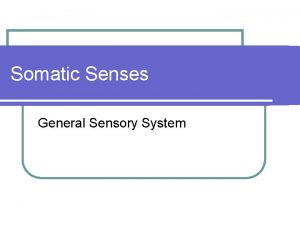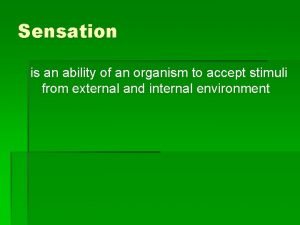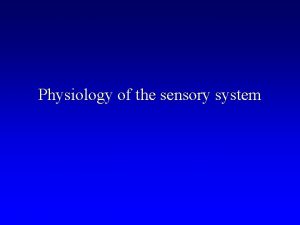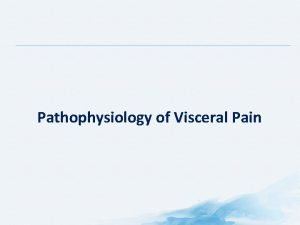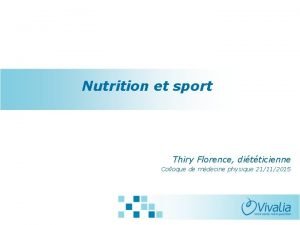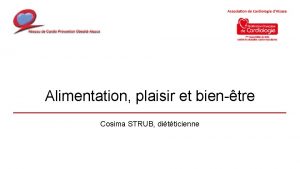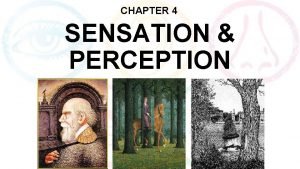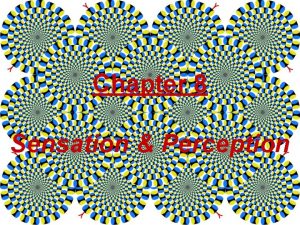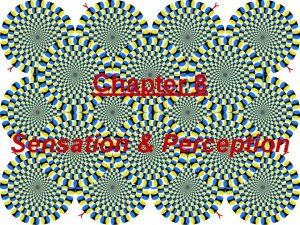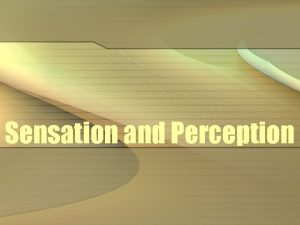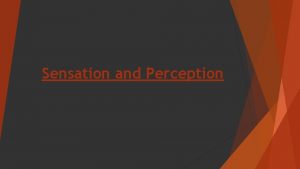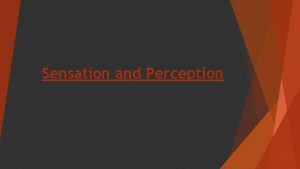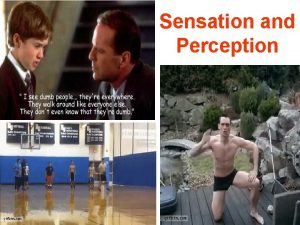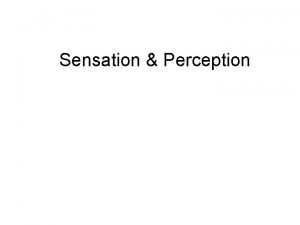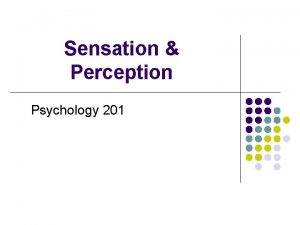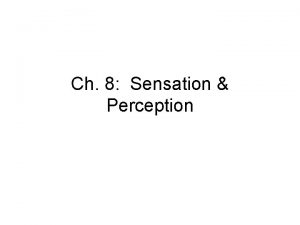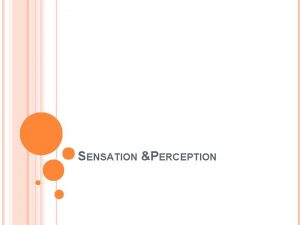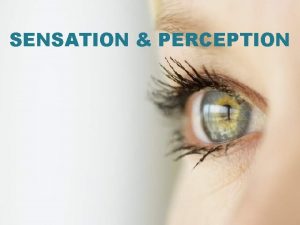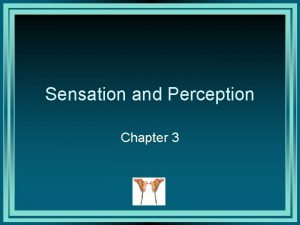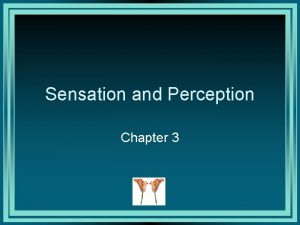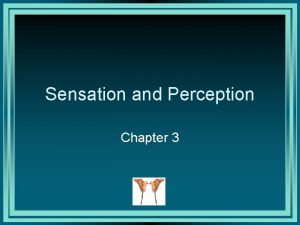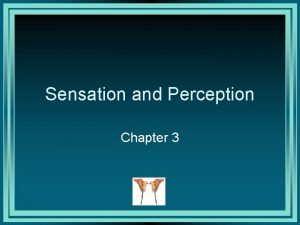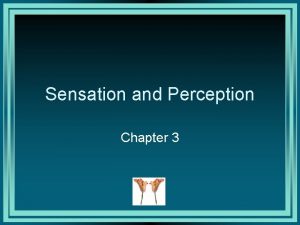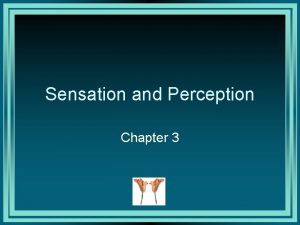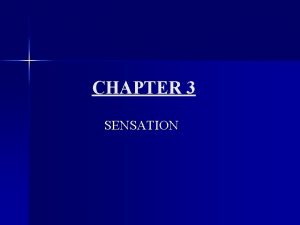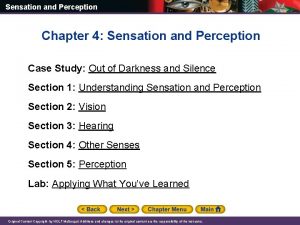Chapter 3 Sensation and Perception Learning Outcomes Define



































![[Insert Figure 3. 6] [Insert Figure 3. 6]](https://slidetodoc.com/presentation_image/228d2d9b35690a25a4854f4854a3d6b4/image-36.jpg)





















































- Slides: 89

Chapter 3: Sensation and Perception

Learning Outcomes • Define and differentiate between sensation and perception. • Identify the parts of the eye; explain the properties of light and theories of color vision.

Learning Outcomes • Describe the chemical senses. • Explain the properties of the skin senses and theoretical explanations for pain.

Learning Outcomes • Describe the organization of visual perceptions. • Identify the parts of the ear; describe the sense of hearing.

Learning Outcomes • Describe the kinesthetic and vestibular senses. • Explain why psychologists are skeptical about extrasensory perception.

Sensation and Perception

What are Sensation and Perception? • Sensation is stimulation of sensory receptors and transmission of sensory information to the central nervous system. • Perception is process by which sensations are organized and interpreted to form an inner representation of the world.

Truth or Fiction? • People have five senses.

Truth or Fiction? • People have five senses. • FICTION!

Absolute Threshold • Weakest amount of a stimulus that can be distinguished from no stimulus at all – Detected 50% of the time

Truth or Fiction? • If we could see waves of light with slightly longer wavelengths, warm-blooded animals would glow in the dark.

Truth or Fiction? • If we could see waves of light with slightly longer wavelengths, warm-blooded animals would glow in the dark. • TRUE!

Subliminal Stimulation • Sensory stimulation that is below a person’s absolute threshold for conscious perception – Visual stimuli flashed too briefly to be processed – Auditory stimuli played a volume to low to consciously hear or played backward

Difference Threshold • Minimum difference in magnitude of two stimuli required to tell them apart – Detected 50% of the time • Weber’s constant – Standard of difference • Just noticeable difference (JND) – Minimum difference a person can detect

Signal-Detection Theory • Stimulus characteristics and psychological factors interact to influence whether a stimulus is detected.

Truth or Fiction? • People sometimes hear what they want to hear.

Truth or Fiction? • People sometimes hear what they want to hear. • TRUE!

Feature Detectors • Neurons that respond to different aspects of features – visual – respond to lines, color, textures, movement – auditory – respond to pitch, loudness, etc.

Sensory Adaptation • Sensitization – Positive adaptation – Process by which we become more sensitive to stimuli of low magnitude • Desensitization – Negative adaptation – Process by which we become less sensitive to stimuli that remains the same

Vision

Light • Spectrum of electromagnetic energy – Vary in wavelength • Cosmic rays are only trillionths of an inch long • Radio waves extend for miles • Within visible light, color is determined by wavelength

The Visible Spectrum

The Eye • Light enters through a narrow opening – Cornea – transparent eye cover – Iris – muscle; colored part of the eye – Pupil – opening in the iris • Sensitive to light and emotion

The Eye • Lens – Changes in thickness for focusing – Image is projected onto retina • Light Sensitive Surface – Retina • Photoreceptors – Rods, Cones, Bipolar and ganglion cells

The Eye • Optic Nerve – Axons of ganglion neurons form optic nerve – Conducts sensory input to brain (occipital lobe)

The Human Eye

Rods and Cones • Cones – Most densely packed in center of retina (fovea) – Provide color vision • Rods – Provide vision in black and white – More sensitive to dim light than cones

Visual Acuity • Greatest in the fovea • Blind spot – Point in retina where ganglion cells converge • Nearsightedness • Farsightedness • Presbyopia

Light Adaptation • Dark adaptation – Process of adjusting to lower lighting • Cones reach maximum adaptation in about 10 minutes • Rods continue to adapt up to 45 minutes • Adaptation to bright light – Process occurs within a minute or so

Perceptual Dimensions of Color • Hue (color) – Wavelength of light • Value – Degree of brightness or darkness • Saturation – Intensity of color • Psychological associations within cultural settings

Color Wheel

Perceptual Dimensions of Color • Color Wheel – Bend the colors of the spectrum into a circle • Warm and Cool Colors – Green-blue side of color wheel – cool – Yellow-orange-red side of color wheel – warm

Perceptual Dimensions of Color • Complementary Colors – Colors across from one another on color wheel – Mix complementary colors = gray • Refers to light not pigments • Light is the source of all colors – Pigments reflect and absorb light selectively

Truth or Fiction? • When we mix blue light and yellow light, we obtain green light.

Truth or Fiction? • When we mix blue light and yellow light, we obtain green light. • FICTION!
![Insert Figure 3 6 [Insert Figure 3. 6]](https://slidetodoc.com/presentation_image/228d2d9b35690a25a4854f4854a3d6b4/image-36.jpg)
[Insert Figure 3. 6]

Perceptual Dimensions of Color • Afterimage – Persistent sensations of color are followed by perception of the complementary color when the first color is removed

Theories of Color • Trichromatic Theory – Three types of cones • Respond to red, green, or blue • Opponent-Process Theory – Three types of color receptors • Respond to red or green, blue or yellow, or light or dark • Cannot respond to both at simultaneously

Color Blindness • Trichromat – Normal color vision • Monochromat – Totally color blind • Dichromat – Partial color blindness – Discriminate between two colors – More common in males (sex linked trait)

Plates from a Test for Color Blindness

Visual Perception

Visual Perception • Process used to organize sensory impressions caused by the light that strikes our eyes • Sensation is a mechanical process • Perception is an active process – Involves knowledge, expectations, and motivations

Perceptual Organization • Figure – Ground Perception – Ambiguous, unstable figures

The Rubin Vase

Gestalt Rules for Perceptual Organization • Proximity – Nearness of objects • Similarity – Similarity of objects • Continuity – Series of points having unity

Gestalt Rules for Perceptual Organization

Gestalt Rules for Perceptual Organization • Common Fate – Elements moving together are grouped together • Closure – Perception of a complete figure, even when there are gaps in sensory information

Top-Down Versus Bottom-Up Processing • Top-Down Processing – Perception of the whole followed by perception of the parts • Bottom-Up Processing – Perception of the parts leads to perception of the whole

Perception of Motion • Visual perception of motion is based on change of position relative to other objects • Illusions of movement – Stroboscopic motion

Depth Perception • Monocular Cues – Perspective – Relative size – Clearness – Overlapping – Shadows – Texture gradient – Motion parallax

Depth Perception • Binocular Cues – Retinal disparity – Convergence

Perceptual Constancies • Acquired through experience; creates stability – Size Constancy – Color Constancy – Brightness Constancy – Shape Constancy

Visual Illusions • Hering-Helmholtz Illusion – Perceive drawing as three-dimensional • Müller-Lyer Illusion – Interpret length of lines based on experience


Hearing

Sound • Sound waves require a medium; air or water • Sound waves compress and expand molecules of the medium, creating vibrations – A single cycle of compression and expansion is one wave of sound • Human ear is sensitive to sound waves with frequencies of 20 to 20, 000 cycles per second

Pitch and Loudness • Pitch – Frequency (# of cycles per second) – Expressed in hertz (Hz) – Pitch of women’s voice is higher than men’s • Loudness – Height (amplitude) of sound waves – Expressed in decibels (d. B)

Sound Waves of Various Frequencies and Amplitudes

Decibel Ratings of Familiar Sounds

i. Pods and Hearing • 60 – 60 rule – To prevent hearing loss • i. Pod oblivion

The Ear • Shaped and structured to: – capture sound waves – vibrate in sympathy with them – transmit auditory information to the brain

The Human Ear

Parts of the Ear • Outer Ear – Funnels sound waves to the eardrum • Middle Ear – Eardrum, hammer, anvil and stirrup – Acts as an amplifier – Oval window – Round window

Parts of the Ear • Inner Ear – Cochlea • Basilar membrane • Organ of Corti • Auditory nerve

Locating Sounds • Loudness and sequence in which sounds reach the ear provide cues – May turn head to clarify information

Perception of Loudness and Pitch • Related to number of receptor neurons on the organ of Corti – Sounds are perceived as louder when more sensory neurons fire

Perception of Loudness and Pitch • Place theory – Pitch is sensed according to place that vibrates • Frequency theory – Pitch perceived on stimulation of impulses that match the frequency of the sound • Volley Principle – Pitch is discriminated through alternate firing of neurons

Deafness • Conductive deafness – Damage to middle ear – Hearing aids can help • Sensorineural deafness – Damage to inner ear or auditory nerve • Cochlear implants may help with damage to inner ear, but not auditory nerve

The Chemical Senses: Smell and Taste

Smell • Odors trigger receptor neurons in olfactory membrane – Odors are sample molecules of substances in the air • Sensory information about odors is sent to the brain through the olfactory nerve • Odor contributes to flavor of foods

Taste • Taste is sensed through taste cells – Receptor neurons on taste buds • Four primary taste qualities – Sweet, sour, salty and bitter – Umami (fifth basic taste) – savory • Flavor of food depends on odor, texture, temperature and taste • Individuals have taste sensitivities

The Skin Senses

Touch and Pressure • Skin sensory receptors fire when skin surface is touched – Active touching • Some areas of the body are more sensitive – Nerve endings are more densely packed – More sensory cortex is devoted to perception of sensations in those areas

Temperature • Receptors are located just beneath the skin – Skin temperature increases – receptors for warmth fire – Skin temperature decreases – receptors for cold fire • Sensations for temperature are relative

Pain • Nociceptors in skin are stimulated – Pain is usually sharpest where nerve endings are densely packed – Pain can be felt deep within body – No nerve endings for pain in the brain

Pain • Prostaglandins – Facilitate transmission of pain message – Heighten circulation to injured area (inflammation) – Pain-relieving drugs inhibit production of prostaglandins – Emotional response and response to stress affect degree of pain

Phantom Limb Pain • 2 out of 3 combat veterans with amputated limbs report phantom limb pain – May involve activation of nerves in the stump of missing limb – May also involve reorganization of motor and somatosensory cortex

Truth or Fiction? • Many people experience pain “in” limbs that have been amputated.

Truth or Fiction? • Many people experience pain “in” limbs that have been amputated. • TRUE!

Gate Theory of Pain • Nervous system can only process a limited amount of stimulation – Rubbing the pained area competes for neural attention – Closes the “gate” on pain messages to the brain

Acupuncture • Ancient Chinese method of pain control – Research shows it stimulates nerves to the hypothalamus releasing endorphins – Endorphins are similar in structure and effect to morphine

Kinesthesis and the Vestibular Sense

Kinesthesis • Sense that informs you about the position and motion of your body – Sensory information is sent to the brain from sensory organs in joints, tendons and muscles

Vestibular Sense • Housed mainly in semicircular canals in your ears • Monitor your body’s motion and position in relation to gravity

ESP: Is There Perception Without Sensation?

Extrasensory Perception - ESP • Perception through means other than sensory organs – Precognition – Psychokinesis – Telepathy – Clairvoyance

Existence of ESP • Joseph Banks Rhine – Zener cards • Ganzfield Procedure – Method for studying the existence of telepathy • Daryl Bem • No reliable evidence for existence of ESP

Truth or Fiction? • Some people can read other people’s minds.

Truth or Fiction? • Some people can read other people’s minds. • FICTION!
 Chapter 5 sensation and perception
Chapter 5 sensation and perception Chapter 3 sensation and perception
Chapter 3 sensation and perception Chapter 6 sensation and perception
Chapter 6 sensation and perception Psychology chapter 4 sensation and perception
Psychology chapter 4 sensation and perception Five basic tastes
Five basic tastes Sensation perception
Sensation perception Chapter 4 sensation and perception
Chapter 4 sensation and perception What is sensation
What is sensation Gestalt laws of visual perception
Gestalt laws of visual perception Relative height ap psychology
Relative height ap psychology Sensation vs perception
Sensation vs perception Sensation and perception crossword review
Sensation and perception crossword review Sensation and perception
Sensation and perception Perceptionn
Perceptionn Webers law
Webers law Opponent process theory
Opponent process theory Sensation and perception uu
Sensation and perception uu Sensation vs perception
Sensation vs perception Exposé sur la sensation en psychologie
Exposé sur la sensation en psychologie Perception vs sensation
Perception vs sensation Old woman young woman illusion
Old woman young woman illusion Planning goals and learning outcomes
Planning goals and learning outcomes Direct and indirect speech learning objectives
Direct and indirect speech learning objectives Output devices
Output devices Sound energy definition
Sound energy definition Learning outcomes of profit and loss
Learning outcomes of profit and loss Learning outcomes of work and energy
Learning outcomes of work and energy Indian and international number system
Indian and international number system Learning outcomes examples english
Learning outcomes examples english Water cycle learning outcomes
Water cycle learning outcomes Learning objectives for notice writing
Learning objectives for notice writing Objectives of swot analysis
Objectives of swot analysis Learning outcomes of rhymes
Learning outcomes of rhymes Photolysis in photosynthesis
Photolysis in photosynthesis Learning objectives of photosynthesis
Learning objectives of photosynthesis 7 domain of ncbts
7 domain of ncbts Objectives of linear equations in one variable
Objectives of linear equations in one variable Learning outcome generator
Learning outcome generator Purpose of learning outcomes
Purpose of learning outcomes Biological level of analysis
Biological level of analysis Reflective essay on learning outcomes
Reflective essay on learning outcomes Learning outcomes of holy week
Learning outcomes of holy week Holy week objectives
Holy week objectives Headstart early learning outcomes framework
Headstart early learning outcomes framework Learning objectives of fruits and vegetables
Learning objectives of fruits and vegetables Gagne's five categories of learning
Gagne's five categories of learning Arithmetic progression mind map
Arithmetic progression mind map Class 7 english a gift of chappals lesson plan
Class 7 english a gift of chappals lesson plan Cooking learning outcomes
Cooking learning outcomes Ppst
Ppst Learning outcomes prescribes
Learning outcomes prescribes Cas learning outcomes
Cas learning outcomes Conclusion of learning outcomes
Conclusion of learning outcomes State and prove pythagoras theorem
State and prove pythagoras theorem Objectives of vitamins
Objectives of vitamins Learning outcomes of digestive system
Learning outcomes of digestive system Learning outcomes of trigonometry
Learning outcomes of trigonometry Angina pectoris pathophysiology
Angina pectoris pathophysiology Hot seating questions examples
Hot seating questions examples Mqf learning outcomes domains
Mqf learning outcomes domains Learning outcomes of myself
Learning outcomes of myself Human resources learning outcomes
Human resources learning outcomes Business communication systems gcse
Business communication systems gcse Objectives of email writing
Objectives of email writing Define training program
Define training program Examples of learning outcomes
Examples of learning outcomes Objective about mental health
Objective about mental health Affective domain verbs
Affective domain verbs Learning outcomes definition
Learning outcomes definition Junior cycle history learning outcomes
Junior cycle history learning outcomes Affective objectives examples in math
Affective objectives examples in math Proseracer
Proseracer Learning outcomes framework
Learning outcomes framework Institutional learning outcomes examples
Institutional learning outcomes examples Cas learning outcomes
Cas learning outcomes Distal vs proximal
Distal vs proximal Perception checking steps
Perception checking steps Cuadro comparativo de e-learning b-learning y m-learning
Cuadro comparativo de e-learning b-learning y m-learning Chapter 7 vision and perception
Chapter 7 vision and perception Chapter 7 managing risk vision and perception
Chapter 7 managing risk vision and perception Sensation seeking
Sensation seeking Sciatic nerve roots
Sciatic nerve roots Sensation seeking significato
Sensation seeking significato Principles of sensation
Principles of sensation Thermoreceptors
Thermoreceptors Types of sensation
Types of sensation Classification of sensation
Classification of sensation Does muscle spasms cause burning sensation
Does muscle spasms cause burning sensation Ditticienne base sur coute sensation
Ditticienne base sur coute sensation Ditticienne base sur coute sensation
Ditticienne base sur coute sensation





